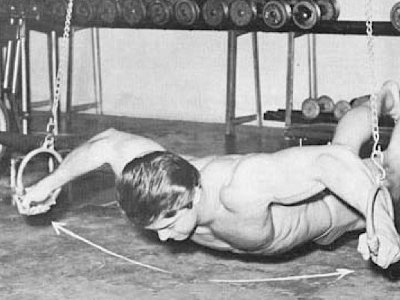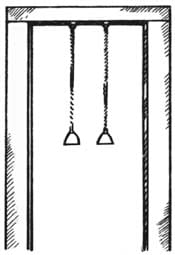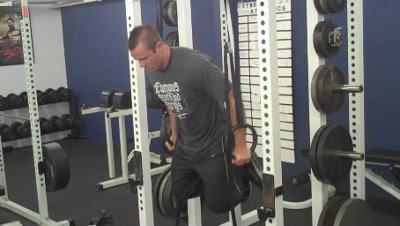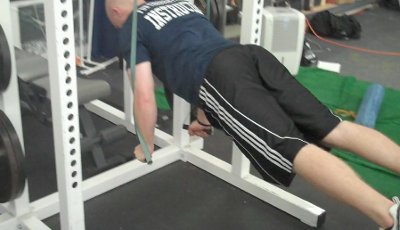
Editor’s note: This is a guest post from Joe Hashey, CSCS.
Every lifter must first be able to control their bodyweight before they progress onto weighted movements. Even after months or years of training, there are always bodyweight exercises in our program. Rings and straps are a great way to increase difficulty for the advanced lifters, while helping them gain a command over their own bodyweight.
History of Ring Training
Ring training was developed during the early 1800s in Germany. The original “rings” looked more like triangles than circles. As you will see in the video near the end of this article, we use both the circle and the triangle variations.

Free hanging rings first appeared during the Olympics in 1924 where gymnastics continued to innovate new movements. Vince Vaughan was seen training on the rings in the 2003 movie Old School. The only importance of Old School is that my athletes all want to attempt the iron cross and yell “still holding!”
Bodyweight Exercises Are for the Weak?
I had an experienced gym “guru” come up to me while I was performing ring dips and say, “You are strong, so why are you wasting your time on bodyweight exercises? Those are for the weak people that can’t lift the iron!”

I invited him to try a set of ring dips and despite his high degree of strength, he mustered up only one…barely. The rings were shaking all over the place, and he didn’t have the relative body strength to control the movements. To the point, fitness is a mixture of different abilities, and control over your own weight is near the top of the list.
Benefits
Rings and straps have a great deal of mobility. As the lifter presses against the rings, they will often vibrate or move and stabilizing this movement creates a higher degree of muscle recruitment. We use them often during the accessory lift portion of our training protocols.
Additionally, both are portable, affordable to make at home, and easy to set up. Most importantly, rings and straps are versatile. We use them for a variety of exercises, unlike many gym machines that serve only one function. In the video below, you will see 23 different exercises we perform with hanging straps and rings, but we also use them on sleds and other apparatuses.
Big Three Ring/Strap Exercises
You won’t see many people using rings like gymnasts – that requires learning a whole new sport. However, these training tools can be implemented with exercises that you regularly perform.
Ring Dip. The primary muscles targeted during the dip are chest, shoulders, and triceps. As mentioned earlier, ring dips provide an entirely different training effect than bar dips. Ring dips will require a great deal of upper body strength and stability.

Ring Push Up. The muscles targeted during the push-up are similar to the dip – chest, shoulders, and triceps. However, due to the movement of the rings, a greater amount of core strength will be required.

Scarecrows. Looks easy, but scarecrows will target your rear delts and the muscles surrounding the scapula like few exercises can. The movement is performed by holding the straps in front of your chin while in the standing position. Pull the straps apart until your arms are straight to the side, parallel to the ground. To make the movement more difficult, simply slide your feet forward.

23 Ring/Strap Exercises
Conclusion
Rings and straps are an effective addition to any training tool box. Athletes have used rings for nearly two centuries. Both training tools have sculpted some of the strongest men (in terms of relative body strength) in Olympic history.
Thanks for reading and please post any questions you may have in the comments!
__________________________________________
Joe Hashey is a Certified Strength and Conditioning Specialist through the NSCA. He is a former D1AA college football player at Colgate University, and owner of Synergy Athletics in Endwell, New York.
Joe can be reached through his popular strength training blog – www.Synergy-Athletics.com. He is currently giving away 2 effective free reports and a 30 minute video to all newsletter subscribers!
Tags: Exercises

